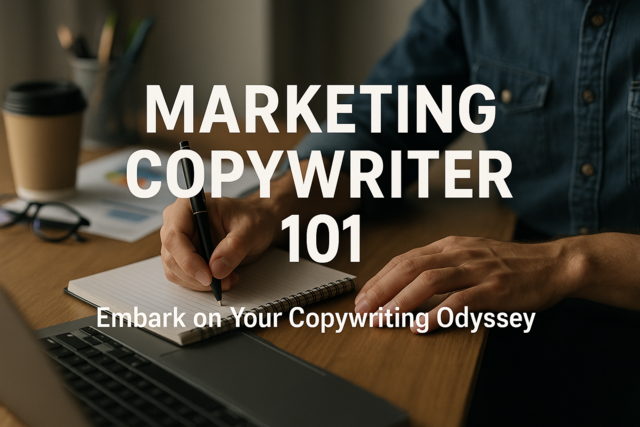In this article, we are going to start to discover how to write effective copy for marketing campaigns.
Terms to Know
Locate the terms below in the dictionary, then fill in the meaning of each word in your "Student Dictionary" by using Google or another search engine to find the definition.
1. Features
2. Benefits
3. Tone (in writing)
Writing to Answer "What" or "How"
Sales copy always answers the question "how?" How is this product going to make consumers' lives better? How is this product going to solve a problem? The purpose of sales copy is to make a sale, so it needs to tell consumers how it is going to help them in order to succeed in making that sale. In addition, it is how are you going to write copy in order to make a sale?
While marketing copy also seeks to solve a problem consumers face, marketing copy answers the question "what?" in addition to sometimes answering the question "how?" What is this company or product? What does it do or what does it offer? What does it mean to consumers? It is also what the brand needs to talk about and why.
Remember that the purpose of marketing copy can be to create brand awareness, not necessarily to go directly after the sale.
Understanding Features and Benefits
It is important to remember that benefits and features are two different things. Features are surface information about your product, such as specs and colors - or what it does. Benefits demonstrate what a consumer or customer can hope to gain or accomplish by using the product. Your readers know what a hair dryer does, but they want to know what they will gain by using your hair dryer.
Effective marketing copy highlights and promotes the benefits, not the features. The benefits are selling points that will appeal to the consumer and help persuade them to become a customer. Benefits tell a consumer what a product or consumer can do for them. Features do not do that. Features are simply facts about the product or service. That said, it can be difficult to distinguish features from benefits, especially when you are first getting started.
A feature is what something is, such as shape, specs, etc.
A benefit is what something does.
Let's look at some examples when talking about yogurt.
|
Feature |
Benefit |
|
Yogurt is nutritious. |
Yogurt is healthier for you than other snacks - and just as filling. |
|
Yogurt comes in many flavors. |
With over 20 flavors to choose from, you are sure to find one that you love. |
|
Yogurt is low in fat. |
Eating yogurt as a snack will not add inches to your waist. Paired with healthy diet and exercise, it can help you shed pounds. |
|
Yogurt is not expensive to buy. |
Finally! Something that is good for you that your budget can afford. |
Take note that the features tell what the yogurt is. It is nutritious, low in fat, affordable, and offers a variety of flavors. The benefits tell the reader what the yogurt can do for them. Always sell the benefits in your copy. Benefits are what persuade people to buy.
Write As If It Matters
You are not special just because you write marketing copy. What you write is not special just because you wrote it. The company, product, or service that you are marketing is not special, and it will not appear to be special just because it is well written.
People are accustomed to reading marketing copy, and they are accustomed to reading advertisements. They are so accustomed, that they do not actually read them. The majority of the time, they just scan through the words, looking for something that catches their eye and convinces them that "this" is "exactly what they were looking for."
Instead of simply writing copy about a company, product, or service, write why that company, product, or service matters. That means asking yourself why it matters before writing. It means researching and finding testimonials and feedback from customers - or from customers of a similar product - and uncovering why it matters. Write about the larger story instead of just the company, product, or service you have been hired to write about.
Take a look at the example below. This example just writes about a product.
The example below goes deeper to tell why it matters.
The difference between these two examples is this. The first example just gives the benefits of the product. Of course, you want to give the benefits. For this product, it is healthy hair without a chemical-based shampoo. The first example accomplishes that.
However, the second example tells why the product matters - and gives the benefits. The product matters because this shampoo gives you healthy hair that has volume and shine. For this example, the copywriter researched feedback from customers from other products and learned that, while customers were happy with the way the shampoo made their hair look, that they also had to use more conditioner because of the damage the chemicals in the shampoo caused.
Make a Connection
You can write about a product and its benefits. Or you can draw a connection between a product and the consumers in its target market by using the benefits to make that connection. Whenever you write marketing copy, write about the experience the consumer will have when they use that product or take advantage of that service.
Here is an example. We googled hair salons, and clicked on the first two results that we saw. The first salon told about their services. On the home page, it had one picture of a woman with beautiful hair, then links to view the salon's prices, services, and contact information. It contained effective marketing copy, but it did little to evoke the experience a customer would have by selecting that salon.
The second hair salon website had the same information on the home page, but it also had copy promoting the virtual makeover feature on their site. It offered customers the opportunity to view themselves after a visit to their salon. It evoked the experience they would have.
Which salon would you rather visit?
Always write copy that connects with consumers. Keep in mind that there are other companies and other products out there marketing similar services, concepts, and products to consumers. The key to preventing them from choosing a competitor is giving them more than just a description. Evoke the experience instead.
Here are some ways to evoke an experience in the copy you write:
1. Use sensory words to evoke the five senses. For example: "An aromatic blend of soft and fresh flowers."
2. Evoke emotions. The hair salon we used in the second example evoked emotions for visitors to the website, because they could upload a picture of themselves and see how beautiful they will look with their new haircut.
3. Tell a story. We discussed this earlier in an earlier article. When you tell a story, you go beyond telling them about a brand. You make them feel like part of it.
Writing Using the Correct Tone
The tone that you use in copy is defined as the attitude you take toward the consumers who read it. The tone can be conveyed through your choice of words or how you structure and write your sentences. When you write copy, you want to connect with consumers in a way that they relate to the brand and want to be a part of it by doing business with the company. You want to bring the copy and the brand to life so that consumers not only read the copy, they breathe it in.
Listen, copy can be flat and boring. As stated earlier in this article, most consumers do not like to read copy for just that reason. The tone you use in your copy is what will make them want to read. It will connect with them, inspire interest, grab attention, and ultimately turn consumers into customers.
In the table below, you will find examples of different tones you can use in copy, as well as how to write to create that tone. You will also find examples of industries that use each tone.
|
Tone |
How to Create It |
Suggested Industries |
|
Expensive, Elegant |
Flowing sentences that are lengthier. Use more adjectives than action verbs. Give minimal details. |
Boutiques and salons. High end items targeted toward wealthier women. |
|
Energetic |
Bullet points. Fragmented sentences. Short words that contain power and punch. Fast paced. |
Gyms and exercise programs. Fun social apps. Brands for teens. |
|
Innovative |
Conversational language. Write to the customer. "You need." Use testimonials |
App companies, software companies, agencies |
|
Dependable |
Warm words that make consumers feel comfortable and safe. Use parallel statements. Avoid exclamation points. Avoid using high-emotion. |
Insurance companies. Schools and courses. Hosting companies. |
The Different Styles of Copy
Marketing is a science because it is based on both testing to see what works and using what has worked to find success in the here and now. Copywriting is part science as well. You can look at what competitors are doing to see what is working. You can listen to what consumers say, then deliver what they want. You can also use copy that has worked in the past as a foundation to create copy that will work now.
However, copywriting is also part art, because it requires creativity. The copy you create requires style. It requires the copywriter to be able to evoke emotion in consumers, much like a painting evokes emotion for art lovers.
As a marketing copywriter, you will decide what style of copy to write based on the science behind it. The science is determined by the competitors and consumers. But you will create the copy and bring it to life using your creativity. You will take the blank canvas you have open in a word processing document, and bring it to life with your words.
Take a look at some of the different styles of copy listed below. Learn to recognize them as you read website copy and start to pay more attention to marketing copy in general. When you spot one of these types of copy, give some thought to why that style was chosen and why it is effective with consumers.
Plain copy. Plain copy is just the facts and benefits. For some industries, this is the most effective type of copy.
Storytelling copy. Storytelling copy tells a story that helps consumers relate to the brand. It can also be a story that shows how the product solves the problem consumers face.
Conversational copy. This is kitchen table type copy. You write it as if you are talking directly to the consumer. It is "you and me" copy, because you will use personal pronouns when you write. "You have to see this!" "I thought the same thing you did when I."
Imaginative copy. Imaginative copy asks consumers to "imagine if." When you write imaginitive copy, you ask consumers to imagine how they will think, feel, or look after using the product or service.
Frank copy. Frank copy reveals the weaknesses of the product before revealing the strengths and benefits. "Look, I'm not going to lie to you. This product will not." This type of copy can build trust with consumers, because it is honest. It is frank.
Rejection copy. Rejection copy makes consumers believe they might be qualified to get the product. Think of a gold card or a membership to a swanky resort. "We do not accept everyone, only the."






















